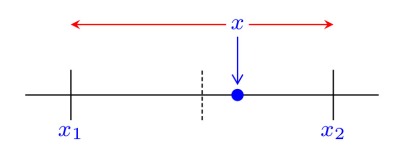A polar decomposition of with
is a factorization
, where
has orthonormal columns and
is Hermitian positive semidefinite. This decomposition is a generalization of the polar representation
of a complex number, where
corresponds to
and
to
. When
is real,
is symmetric positive semidefinite. When
,
is a square unitary matrix (orthogonal for real
).
We have , so
, which is the unique positive semidefinite square root of
. When
has full rank,
is nonsingular and
is unique, and in this case
can be expressed as
An example of a polar decomposition is
For an example with a rank-deficient matrix consider
for which and so
. The equation
then implies that
so is not unique.
The polar factor has the important property that it is a closest matrix with orthonormal columns to
in any unitarily invariant norm. Hence the polar decomposition provides an optimal way to orthogonalize a matrix. This method of orthogonalization is used in various applications, including in quantum chemistry, where it is called Löwdin orthogonalization. Most often, though, orthogonalization is done through QR factorization, trading optimality for a faster computation.
An important application of the polar decomposition is to the orthogonal Procrustes problem1
where and the norm is the Frobenius norm
. This problem, which arises in factor analysis and in multidimensional scaling, asks how closely a unitary transformation of
can reproduce
. Any solution is a unitary polar factor of
, and there is a unique solution if
is nonsingular. Another application of the polar decomposition is in 3D graphics transformations. Here, the matrices are
and the polar decomposition can be computed by exploiting a relationship with quaternions.
For a square nonsingular matrix , the unitary polar factor
can be computed by a Newton iteration:
The iterates converge quadratically to
. This is just one of many iterations for computing
and much work has been done on the efficient implementation of these iterations.
If is a singular value decomposition (SVD), where
has orthonormal columns,
is unitary, and
is square and diagonal with nonnegative diagonal elements, then
where has orthonormal columns and
is Hermitian positive semidefinite. So a polar decomposition can be constructed from an SVD. The converse is true: if
is a polar decomposition and
is a spectral decomposition (
unitary,
diagonal) then
is an SVD. This latter relation is the basis of a method for computing the SVD that first computes the polar decomposition by a matrix iteration then computes the eigensystem of
, and which is extremely fast on distributed-memory manycore computers.
The nonuniqueness of the polar decomposition for rank deficient , and the lack of a satisfactory definition of a polar decomposition for
, are overcome in the canonical polar decomposition, defined for any
and
. Here,
with
a partial isometry,
is Hermitian positive semidefinite, and
. The superscript “
” denotes the Moore–Penrose pseudoinverse and a partial isometry can be characterized as a matrix
for which
.
Generalizations of the (canonical) polar decomposition have been investigated in which the properties of and
are defined with respect to a general, possibly indefinite, scalar product.
References
This is a minimal set of references, which contain further useful references within.
- Nicholas J. Higham, Functions of Matrices: Theory and Computation, Society for Industrial and Applied Mathematics, Philadelphia, PA, USA, 2008. (Chapter 8.)
- Nicholas Higham, Christian Mehl, and Françoise Tisseur, The canonical generalized polar decomposition, SIAM J. Matrix Anal. Appl. 31(4), 2163–2180, 2010.
- Nicholas J. Higham and Vanni Noferini, An algorithm to compute the polar decomposition of a
matrix, Numer. Algorithms 73, 349–369, 2016.
- Yuji Nakatsukasa and Nicholas J. Higham, Stable and efficient spectral divide and conquer algorithms for the symmetric eigenvalue decomposition and the SVD, SIAM J. Sci. Comput. 35(3), A1325–A1349, 2013.
- Dalal Sukkari, Hatem Ltaief, Aniello Esposito, and David Keyes, A QDWH-based SVD software framework on distributed-memory manycore systems, ACM Trans. Math. Software 45, 18:1–18:21, 2019.
Related Blog Posts
- Faster SVD via Polar Decomposition (2015)
- What Is a Generalized Inverse? (2020)
- What Is a Matrix Square Root? (2020)
This article is part of the “What Is” series, available from https://nhigham.com/category/what-is and in PDF form from the GitHub repository https://github.com/higham/what-is.
Footnotes:
Procrustes: an ancient Greek robber who tied his victims to an iron bed, stretching their legs if too short for it, and lopping them if too long.


